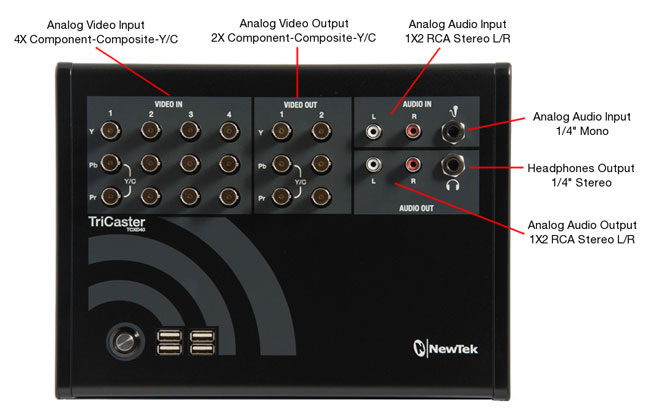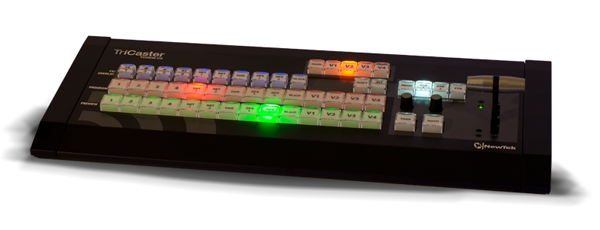Review: NewTek TriCaster 40
With the TriCaster 40, NewTek's newest compact video switcher and live production box, NewTek goes retro and down-market but still delivers a capable solution at a price $20k (or more) below other models in the TriCaster line. And that, in itself, should be cause for rejoicing.
In addition to AirPlay, there's also the ability to use iVGA virtual inputs. The iVGA option has been around for a number of years on various TriCaster models, with varying success, but the TC 40 seems to have nailed this option. A plug-in is added to the presenter's laptop or desktop, and the iVGA-flavor of VNC sends anything from that computer--be it PowerPoint, web pages, or even Skype video directly to the TC 40.
The term "directly" requires both the TC 40 and the iVGA-equipped computer to be on the same local area network (VNC works across LANs but has limited success across the public internet or virtual private network). For those iVGA units on the LAN, all a TC 40 user need do is select one of the two Network input sources.
NewTek also notes that audio can be sent across some types of virtual inputs, specifically 3Play from a NewTek 3Play device, or AirPlay content. To access this audio-input option, use the External Audio tab to choose one of these audio sources.
Source Outputs
The TC 40 has two columns of output video connectors, a single pair of RCA audio connectors, and a headphone jack.
On the video connectors, the first column's output signal is user-selectable, based on the session parameters. In other words, if the primary resolution for the session--NewTek's name for a video mixing event--is set to 720p, the first column will output 720p signal in component form.

The second column of video connectors, also three BNCs like the first column, always outputs an SD-quality video signal. Users can choose to make this output component, composite, or S-video (Y/C) for use in various scenarios.
We see this SD-only output a beneficial second option for streaming, especially if the primary streaming output on the TC 40 is set at HD bitrates. The use of an external analog encoder--many of which have analog inputs and a USB output to connect to a laptop or desktop--could allow additional streaming of SD content independent of the HD streaming output of the TC 40.
Recording and Streaming
When it comes to the types of streams the TC 40 can output, it's obvious that NewTek is taking a page from the TriCaster 4xx and 8xx streaming playbook: The Configure Stream Connection panel offers the ability to log in to popular content delivery networks (CDNs) for easy configuration of a stream via those service providers.
In terms of the interface for setting up streaming, NewTek uses a three-pane setup to store connection configuration settings for later use via a drop-down menu. Using a built-in web browser, users can select from a variety of options, including Flash Video streaming, Windows Media (in both pull- and push-based configurations), and the newer browser-based streaming.
Browser-based streaming is NewTek's way of referring to what may commonly be referred to as HTML5 video. NewTek uses an H.264 codec, as well as an MPEG-2 codec.
For HD streaming, the H.264 codec is used at 3 Mbps, which NewTek calls "ideal for web use" although we think that bitrate is much too low for proper 1080p output. For archival, TriCaster relies on the QuickTime container, creating an MPEG-2 based MOV file. For the geeks in the audience, NewTek uses High Profile (not Main) and records I-frame-only 4:2:2 content at 8 bits.
While the IsoCorder option isn't available on TC 40--NewTek has to save some tricks for the 4xx and 8xx units--the internal 2 TB hard drive can record up to 20 hours of 1080i footage. Your mileage may vary, based on whether yo''re using the MPEG-2 or H.264 archival options, but that's an impressive amount of storage capability for a $4995 unit.
For those interested in editing in NewTek's video editing tool, SpeedEdit, there's also an option of encoding via SpeedHQ. Note that SpeedEdit is not included in the price of the TC 40--a first for an HD-capable TriCaster.
User Interface
Like all TriCasters, the user interface can either be accessed on-screen or via a HUI (Human User Interface). For the TC 40, NewTek allows the use of the venerable LC-11 or the newer, streamlined TriCaster 40 CS control surface. The TC 40 CS looks like what the LC-11 might've looked like when it grew up, and offers an elegant HUI for those who love the feel of tactile button-crunching beneath their fingers.

One trick on the user experience front is to access the Swap Primary Monitor option. This gives the user an easy way to reverse which monitor the MultiView shows up on, swapping that monitor for the TriCaster's interface. Maybe it's because I'm left-handed or right-brained, but I find this feature is handy when I need to concentrate more on one of the two monitor outputs.
Related Articles
The ultra-portable TriCaster Mini joins the TriCaster 40 at the sub-$6k end of the TriCaster line, but weighs in 10 lbs. lighter and adds HDMI input ISO-recording, a new compact control surface, an internal monitor, and more.
NewTek's latest addition to the TriCaster line is a slim form factor, power-packed SDI-only solution.
With Rundown Creator's TriCaster integration, title templates, graphics, audio clips, and video clips on your TriCaster all show up automatically in Rundown Creator, and inserting them into your scripts is as simple as selecting the one you'd like in the Script Editor.
Launch of new features for NewTek's entry-level video mixing product leads to price increase.
TriCaster 40 v2 entry-level HD multicam video production studio adds customizable animated transitions, network-style titles and graphics, and improved file interoperability
Frisco, Texas-based NBA Development team the Texas Legends have created a custom-built mobile streaming and broadcast production trailer boasting its own 10x10 studio and featuring NewTek TriCaster for switching and streaming, a ProSonus mixer for audio mixing, and NewTek 3Play for instant replay, with 3 benches for production crew.
Streaming Media Producer editor Steve Nathans-Kelly interviews NewTek SVP on the red carpet at Streaming Media West regarding the NewTek TriCaster 40 and the present and future of affordable, accessible live production and webcasting.
Half the size of the NewTek TriCaster 855, the TriCaster 455 holds its own for live production and streaming at a lower price point. We really like the functionality of the 455, especially when it comes to one-button streaming, a robust but manageable control surface, and the ability to add AirPlay virtual inputs to the HD-SDI physical inputs.
NewTek returns to its roots of empowering entry-level and budget-constrained live producers with its first sub-$5k HD-capable, multi-camera live production system
The Extreme version provides a number of enhancements over the original TCXD850 including full HD recording treatment, with the ability to record 1080p30 of any discrete input as well as the program or AUX outputs (the TCXD850 could record only outputs). This extended ability to record both inputs and outputs means that 850 Extreme can perform isolation recording of up to 8 simultaneous camera inputs with its proprietary IsoCorder software.